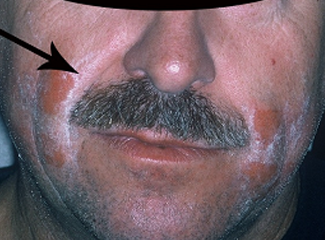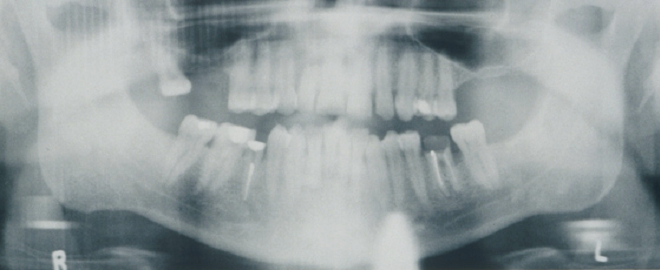Cephalic Tetanus Associated With Dental Caries and Root Canal
A 47-year-old man in no apparent distress presented with intermittent facial pain, involuntary right facial muscle contractions, bilateral muscle spasms, trismus, involuntary tongue protrusions, tongue trauma, and an excessive gag reflex. He had taped a pacifier to his face to prevent tongue damage during involuntary clenching.

A 47-year-old man in no apparent distress presented with intermittent facial pain, involuntary right facial muscle contractions, bilateral muscle spasms, trismus, involuntary tongue protrusions, tongue trauma, and an excessive gag reflex (Figure 1, left). He had taped a pacifier to his face to prevent tongue damage during involuntary clenching.
Sometime before the patient’s initial visit to the oral medicine specialist, he had been seen by his dentist for management of caries and an inadequate root canal fill in teeth 30 and 29, respectively. Six months after this intervention, he returned with left facial pain related to deep caries in tooth number 12. This was temporarily treated with pulp extirpation and placement of CMCP and a temporary filing. An antibiotic was prescribed. Within 2 months, the patient began to experience right-sided face/head/neck pain and throat swelling coupled with eye droop. Because there was submandibular lymphadenopathy as well, his condition was thought to be related to dental infection. A root canal was performed on tooth number 29 and an antibiotic was prescribed. However, symptoms persisted and worsened to include bilateral jaw muscle spasms, trismus, gagging with slight stimulation of the mouth or tongue, and involuntary tongue protrusions.
Medical History
The patient’s medical history was unremarkable.
Clinical and Radiographic Findings
Extraoral examination revealed involuntary contracture of the facial musculature on the right side, without any weakness. The patient exhibited a hyperactive gag response, a positive glabellar response, and a hyperactive jaw jerk. The masticatory muscles were nontender. The maxillary opening was within the midline, but it was restricted and associated with right mandibular pain. Intraoral examination revealed evidence of a prior tongue laceration; otherwise, findings were unremarkable.
Cranial nerve examination was unremarkable except for fifth nerve bilateral trismus with intermittent severe spasms provoked by jaw movement. Perioral patchy erythema was caused by the tape used to secure the pacifier.

Panoramic imaging shows the root canal in teeth 29 and 30 and endodontic therapy in teeth 19 and 29. Tooth 19 has crown breakdown and inadequate fill. Teeth 2 and 3 are missing (Figure 2, left). The findings on MRI and CT imaging were normal.
Laboratory Findings
Serum calcium and electrolyte levels were normal. Electromyography of facial muscles showed abnormal activity in the right facial muscles.
Examination Findings
Serum calcium and electrolyte levels were normal. MRI and CT findings were normal. Electromyography revealed abnormal right-sided muscular activity.
All blood and urine laboratory tests were normal after hospital admission. ECG showed an irregular heart rhythm, which was converted to normal with injection of a bolus of lidocaine and 20 mg of propranolol q6h. Oral diazepam q6h was prescribed along with 500 mg of intramuscular tetanus immunoglobulin, along with oral and intravenous antibiotics.
The patient stabilized, but after release, he continued to have intermittent jaw spasms and anxiety after diazepam withdrawal. Additional ECG and chest radiographs and an echocardiogram were normal. Over time, the patient became medically stable but needed treatment for a subsequent abscess of tooth number 30.
Differential Diagnosis
Based on the initial finding, the differential diagnosis included:
• Temporomandibular disorder
• Oral infection/alveolar abscess
• Encephalitis
• Cephalic tetanus
• Peritonsillar abscess with internal pterygoid involvement
Final Diagnosis
Following normal MRI and CT findings; nonresponse to initial antibiotic therapy; negative laboratory studies; and the absence of jaw muscle palpation pain or TMJ tenderness or tooth pain with percussion, a diagnosis of cephalic tetanus was made.
Discussion
Cephalic tetanus is rare. Fewer than 20 cases are reported in the literature. Data from the CDC suggest that two-thirds of all cases (and in the 2% of cephalic patients reported between 1998 and 2000) that occur in the United States involve patients older than 50 years.1 The condition is caused by tetanospasmin, a protein toxin produced by the anaerobic bacterium Clostridium tetani. When C tetani found in soil inoculate poorly oxygenated sites (necrotic tissue, for instance), the spores germinate and become bacilli that produce the neurotoxin. This toxin blocks the release of the inhibitory neurotransmitters glycine and GABA at the presynaptic terminal.2
The most common symptoms of cephalic tetanus are those associated with cranial nerve dysfunction: facial twitching or spasm/trismus; pain in the throat, face, or head; dysphagia; neck and jaw stiffness; malaise; anxiety; and emotional instability.3 Data suggest that facial/throat pain may also be a primary symptom in cephalic tetanus.4 Typically, the patient’s vaccination status is unknown. There usually is a history of facial trauma and, as apparently occurred in the present case, either caries or a root canal procedure may provide a point of entry for C tetani.5 At least 1 reported case has occurred after tongue piercing.6,7
The incubation period is typically 14 days. A shorter incubation associated with a poorer prognosis and higher mortality. Respiratory muscle spasm is a major complication of generalized tetanus, which is reported to follow cephalic tetanus in some cases.8
Initial treatment includes wound debridement, penicillin and tetanus immunoglobulins, and aggressive supportive care.
The CDC recommends that all persons should be actively immunized for tetanus, but particularly those in the high-risk groups (eg, diabetics, IV drug abusers, persons of Hispanic ethnicity, pregnant women, persons with philosophical objections to vaccines, and those who might not have received a primary series [immigrants, for example]) should also be actively immunized. The typical adult program includes 3 doses and a booster every 10 years.
Teaching Points
1. The mouth needs to be considered as a point of entry for C tetani bacilli. Cephalic tetanus has been associated with gross caries, tooth extraction, periodontal abscess, cheek trauma, dental restoration, tongue laceration, and tongue piercing. Presenting symptoms and signs can be confused with dental abscess, temporomandibular disorders, or central pathology.
2. At least one-third of patients with cephalic tetanus progress to generalized tetanus; prognosis worsens with delayed diagnosis and intervention.
References:
1. Pascual BF, McGinley EL, Zanardi LR, et al. Tetanus Surveillance United States, 1998-2000. http://www.cdc.gov/mmwr/preview/mmwrhtml/ss5203a1.htm.
2. Abrutyn E. Tetanus. In: Braunwald E, Fauci A, Kasper DL, et al, eds. Harrison’s Principles of Internal Medicine. 15th ed. New York: McGraw-Hill; 2001:918-920.
3. Chebel S, Letaief L, Boughammoura-Bouatay A, et al. Multiple cranial nerve involvement: consider the diagnosis of cephalic tetanus. A case report and review of the literature [in French]. Rev Neurol (Paris). 2010;166:948-950.
4. Babajews A, Nicholls MW. Tetanum associated with dental sepsis. Br J Oral Maxillofac Surg. 1985;23:36-40.
5. Burgess JA, Wambaugh GW, Koczarski MJ. Report of case: reviewing cephalic tetanus. J Am Dent Assoc. 1992;123:67-70.
6. HY Yu C, Minnema BJ. Bacterial infections complicating tongue piercing. Can J Infect Dis Med Microbiol. 2010 Spring; 21(1):e70–e74.
7. Dyce O, Bruno JR, Hong D, et al. Tongue piercing. The new “rusty nail”? Head Neck. 2000;22:728-732.
8. Jagoda A, Riggio S, Burguieres T. Cephalic tetanus: a case report and review of the literature. Am J Emergency Med. 1988;6:128-130.